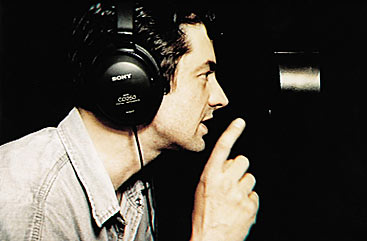
Born in 1960 in Nantes (FR)
Lives and works in Nantes (FR)

1994
Wood, panels, video camera, monitors, VHS recorder, headphone
Dimensions variables
Year of Purchase: 1994
By taking part in that critical and acerbic spirit of the art of the 1980s (Sherman, Wegman, Gilbert & George…) which made use of appropriation and ridicule of stereotypes, and the failure and impossibility of all statement and declaration, Sorin would probe his everyday gestures, his solitary obsessions, his lost memory, by using himself in real-life situations in grotesque and often ironical and disconcerting sketches and vignettes, which, like the burlesque cinema of Méliès and Keaton, or Tex Avery, and the distorting scenes of late 19th century fairground films, deal with the degeneration and failure of social inclusion.
To this end, he makes small films, first in super 8, then, from 1989 onward, in video in which the fragmented image and its obsessive repetition capture autobiographical moments (Le réveil/Waking up, 1988), buried desires (C’est mignon tout ça/It’s all so cute, 1993), existential cul-de-sacs (J’ai même gardé mes chaussons pour aller à la boulangerie/I’ve even kept my slippers on to go to the bakery, 1993), in a voyeuristic relationship that is invariably unassumed because it is prerecorded with this intimate public which must be drawn in, as if it were impossible to remain alone with the other in oneself. As an actor and pathetic spectator, grimacing with an awkward inertia in what is unfinished and always disturbed, the artist uses the style of performance and its documentary quality, rejecting its sacrificial, heroic and social aspects (Fluxus, Beuys, Burden, Nauman…) in the broken distance of contemporary communication (voice-over, shy and monotonous explanations, excuses, apologies, recordings, boxes…).
Even when he leaves his enclosed world to use the exhibition venue (La belle peinture est derrière nous/The beautiful painting is behind us, 1989, Peinture et hygiène/Painting and Hygiene, 1992, Je me regarde le Sorin, 1993), his address to the spectator turned object and subject is marked by embarrassment and aggressiveness: nothing is in its place. Displaced, off-centered, the spectacle is behind, and the voyeur at fault, in front of the box, Je me regarde le Sorin rejects any outside intrusion and defends itself against the confusion caused by the loss of expressiveness in reality and art. As a virtuoso of video synchronization and its fragmentation, Sorin treats the body like a thought-provoking alter ego (Jean-Loup) with which any relation inevitably culminates in a break and a lack of understanding. In endless duplication, these stories express anxiety, intolerance and social fracture in a world that has lost many of its ideologies.
Maïté Vissault